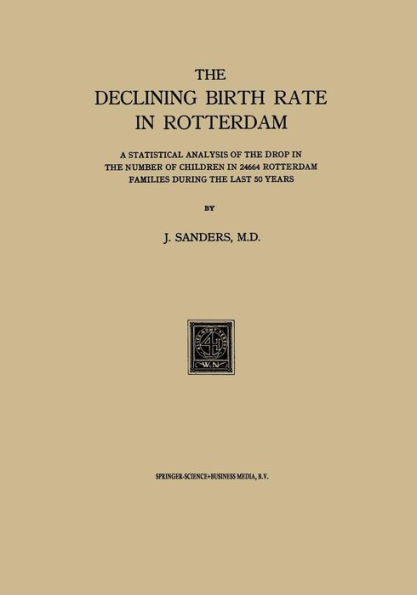The Declining Birth Rate in Rotterdam: A Statistical Analysis of the Drop in the Number of Children in 24644 Rotterdam Families During the Last 50 Years
In the years after the war the problem of population and especially the birth-rate movements excited general interest in all countries. In the Netherlands also all kinds ot scientific men occupied themselves with this subject; not only economists, sociologists and theologians but also medical men studied the population problem in all its various aspects. It has appeared that it is only possible to obtain a complete analysis of the population problem by making a careful scientific investigation of every part of it. Evidently this was also the author's conception of the problem. By examining 25000 families he submitted the birth-rate movement of a large town to a scientific investigation. Neither political nor religious or other than scientific motives prompted him in undertaking this work; the examination was begun and ended quite objectively which lends this book its value. For only an objective examination of s tch a complex phe- nomenon like the birth-rate movement is of importance for science. The examination was inspired by the working program of the I nterna- tional Union for the scientific Investigation of Population Problems. It produces surprising results and shows in figures how natality presented itself in a metropolis like Rotterdam during the last fifty years. It is to be hoped that this study may be followed by many similar in- vestigations, also for the country.
1119383509
The Declining Birth Rate in Rotterdam: A Statistical Analysis of the Drop in the Number of Children in 24644 Rotterdam Families During the Last 50 Years
In the years after the war the problem of population and especially the birth-rate movements excited general interest in all countries. In the Netherlands also all kinds ot scientific men occupied themselves with this subject; not only economists, sociologists and theologians but also medical men studied the population problem in all its various aspects. It has appeared that it is only possible to obtain a complete analysis of the population problem by making a careful scientific investigation of every part of it. Evidently this was also the author's conception of the problem. By examining 25000 families he submitted the birth-rate movement of a large town to a scientific investigation. Neither political nor religious or other than scientific motives prompted him in undertaking this work; the examination was begun and ended quite objectively which lends this book its value. For only an objective examination of s tch a complex phe- nomenon like the birth-rate movement is of importance for science. The examination was inspired by the working program of the I nterna- tional Union for the scientific Investigation of Population Problems. It produces surprising results and shows in figures how natality presented itself in a metropolis like Rotterdam during the last fifty years. It is to be hoped that this study may be followed by many similar in- vestigations, also for the country.
54.99
In Stock
5
1

The Declining Birth Rate in Rotterdam: A Statistical Analysis of the Drop in the Number of Children in 24644 Rotterdam Families During the Last 50 Years
179
The Declining Birth Rate in Rotterdam: A Statistical Analysis of the Drop in the Number of Children in 24644 Rotterdam Families During the Last 50 Years
179Paperback(1931)
$54.99
54.99
In Stock

Product Details
| ISBN-13: | 9789401700245 |
|---|---|
| Publisher: | Springer Netherlands |
| Publication date: | 01/01/1931 |
| Edition description: | 1931 |
| Pages: | 179 |
| Product dimensions: | 7.01(w) x 10.00(h) x 0.02(d) |
From the B&N Reads Blog
